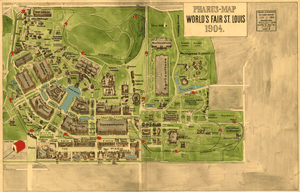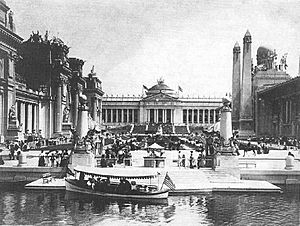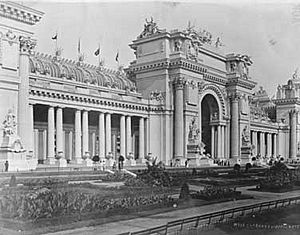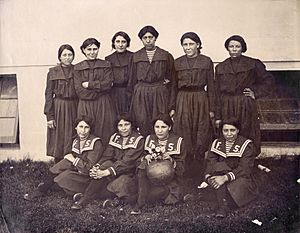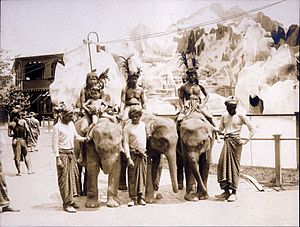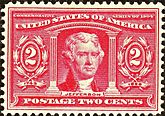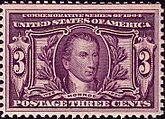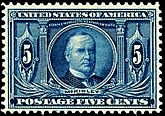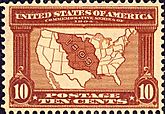Louisiana Purchase Exposition facts for kids
Quick facts for kids 1904 St. Louis |
|
|---|---|

Poster for the Exposition painted by Alphonse Mucha
|
|
| Overview | |
| BIE-class | Universal exposition |
| Category | Historical Expo |
| Name | Louisiana Purchase Exposition |
| Area | 1,270 acres (510 hectares) |
| Visitors | 19,694,855 |
| Participant(s) | |
| Countries | 62 |
| Location | |
| Country | United States |
| City | St. Louis |
| Venue | Forest Park, Washington University in St. Louis |
| Coordinates | 38°38′18.6″N 90°17′9.2″W / 38.638500°N 90.285889°W |
| Timeline | |
| Opening | April 30, 1904 |
| Closure | December 1, 1904 |
| Universal expositions | |
| Previous | Exposition Universelle (1900) in Paris |
| Next | Liège International (1905) in Liège |
The Louisiana Purchase Exposition, also known as the St. Louis World's Fair, was a huge international event. It took place in St. Louis, Missouri, United States, from April 30 to December 1, 1904. This fair celebrated 100 years since the Louisiana Purchase in 1803.
The event cost $15 million, paid for by local, state, and federal money. More than 60 countries and 43 of the 45 U.S. states at the time had exhibits. Nearly 19.7 million people visited the fair. It was a place for fun, new products, and popular culture. It also showed off new ideas in history, art, building design, and how people live.
Contents
What Was the Fair About?
The St. Louis World's Fair was held to celebrate the 100th birthday of the Louisiana Purchase. This was when the United States bought a huge area of land from France in 1803. The idea for the fair started in 1898. St. Louis was chosen because it was in the middle of this new territory.
The fair was very big and took a long time to plan. St. Louis first put in $5 million. Then, people and businesses in Missouri donated another $5 million. The U.S. government added the last $5 million. President William McKinley supported the fair, which helped raise money.
The fair was supposed to happen in 1903. But it was delayed until April 30, 1904. This gave more states and countries time to get ready. The fair stayed open until December 1, 1904.
Fairgrounds and Buildings
The fair covered 1,200 acres (about 5 square kilometers). This made it the largest fair ever at that time. It was built in Forest Park and on the campus of Washington University in St. Louis. There were over 1,500 buildings. They were connected by about 75 miles (120 km) of roads and paths. People said it would take more than a week to see everything. The Palace of Agriculture alone was as big as 20 acres.
About 50 foreign countries and 43 U.S. states had exhibits. These showed off industries, cities, and different cultures. There were also over 50 fun attractions on "The Pike." These included educational displays, imaginary trips to faraway lands, and pure entertainment.
Visitors loved the amazing buildings, new foods, popular music, and displays of people from different cultures. The fair showed off American culture. It highlighted new ideas in communication, medicine, and transportation.
Who Designed the Fair?
George Kessler created the overall design for the fairgrounds. He designed many city parks in the Midwest.
A famous St. Louis architect, Isaac S. Taylor, led the design and building of the fair. He chose Emmanuel Louis Masqueray to be his Chief of Design. Masqueray designed several important buildings. These included the Palace of Agriculture and the Palace of Transportation. His designs influenced other city projects across the U.S.
Florence Hayward was a writer who wanted to help with the fair. She became the only woman on the Board of Commissioners. She traveled to Europe to promote the fair. She helped get gifts from Queen Victoria and old items from the Vatican for exhibits.
Amazing New Inventions
The fair showed many inventions that are now part of our daily lives. New ways to use electricity and light for talking and healing were shown. The Chief of Electricity for the fair, W.E. Goldsborough, wanted to teach people about electricity. New ways of transportation were also shown. These would change how people traveled forever.
Communication Innovations
- Wireless Telephone: This was a marvel to visitors. Music or voices were sent from a machine in the Palace of Electricity to a phone receiver outside. The receiver was not connected to anything. When held to the ear, visitors could hear the sound. This "radiophone" was invented by Alexander Graham Bell. It turned sound into light waves and back again. This technology led to today's radio and telephone.
- Early Fax Machine: The telautograph was like an early fax machine. It was invented in 1888 by Elisha Gray. This device could send electrical signals. These signals would make a pen draw on paper, copying what someone wrote on another machine. An improved version was shown at the fair. It was sold for the next 30 years.
Medical Innovations
- Finsen Light: This was a light therapy machine invented by Niels Ryberg Finsen. It used ultraviolet light to treat a skin disease called lupus. Finsen won the Nobel Prize for his work. His invention helped lead to other radiation therapies for diseases.
- X-ray Machine: The X-ray machine was first shown to the public at the 1904 World's Fair. X-rays were discovered in 1895 by Wilhelm Röntgen. He took an X-ray of his wife's hand, showing her bones and wedding ring. Thomas Edison also worked on X-ray machines. The perfected X-ray machine was a big hit at the 1904 fair. Today, X-rays are common in hospitals and airports.
- Infant Incubator: Infant incubators were invented in 1888. But they were not used much at first. To show how helpful they were, incubators with premature babies were displayed at several World's Fairs. At the 1904 fair, E. M. Bayliss showed 24 babies in incubators. Nurses cared for them. Visitors paid 25 cents to see the exhibit. This money helped fund the project. These incubators helped babies with weak immune systems. They provided a clean, warm place. Today, these units, called "isolettes," are very important in caring for newborns.
Transportation Innovations
- Electric Streetcar: Electric streetcars were still quite new in 1904. Outside the Palace of Electricity, a working electric streetcar was shown. It had 1400 feet of track. It demonstrated how fast it could go, how quickly it could speed up, and how well it could stop. Electric railways are still used in many cities today.
- Personal Automobile: One of the most popular attractions was in the Palace of Transportation. It featured automobiles and motor cars. There were 140 models, including ones powered by gasoline, steam, and electricity. The private car made its public debut here. Four years later, the Ford Motor Company started making the Ford Model T. This made cars more affordable for everyone. Cars have grown in popularity and technology ever since.
- Airplane: The 1904 World's Fair held the first "Airship Contest." Flying machines were very new then. The fair offered a $100,000 prize for the best airship. It had to travel at least 15 miles per hour through a course marked by balloons. No one won the grand prize. But the contest did show the first public dirigible (a type of airship) flight in America. Many other airships also flew. This event helped St. Louis become known as "Flight City." Air travel has developed a lot since then. It is now a key part of global society.
Lasting Impact of the Fair
The fair made St. Louis very famous. Many reporters and photographers came to see the city. They saw a city full of energy and busy streets. One person said St. Louis had more energy than any other northern city.
Buildings That Remain

Most of the grand buildings at the fair were temporary. They were made of "staff," a mix of plaster and hemp fibers on a wood frame. They were meant to last only a year or two.
- The Palace of Fine Art, designed by Cass Gilbert, is still standing. It is now the St. Louis Art Museum.
- The Administration Building is now Brookings Hall. It is a famous building at Washington University in St. Louis.
- The huge bird cage at the St. Louis Zoo was built for the fair.
- A Jain temple made of teak wood was in the Indian Pavilion. It was taken apart after the fair. It was later rebuilt in Las Vegas and is now in Los Angeles.
- The Vulcan statue in Birmingham, Alabama, was first shown at the fair. It is a large iron statue.
- The Missouri State building was the largest state building. It burned down just before the fair ended. The current World's Fair Pavilion in Forest Park was built on its site.
- Festival Hall had the largest organ in the world at the time. After the fair, the organ was bought by John Wanamaker. It was moved to his store in Philadelphia. It is now known as the Wanamaker Organ and is much bigger.
- The Jefferson Memorial building was built with money from the fair. It honored Thomas Jefferson. It is now the Missouri History Museum.
New Foods Introduced
Many foods are said to have been invented at the fair. The most popular claim is that the waffle-style ice cream cone was first sold there. It was likely popularized at the fair, not invented. Other foods like the hamburger, hot dog, peanut butter, iced tea, and cotton candy were probably introduced to many people for the first time at the fair.
Dr Pepper and Puffed Wheat cereal were also first shown to a national audience. Annie Fisher, a daughter of former slaves, won a gold medal for her famous beaten biscuits.
The fair was like America's first food court. Visitors could try many fast foods. They could eat in dozens of restaurants. One historian said you could "breakfast in France, take a mid-morning snack in the Philippines, lunch in Italy, and dine in Japan."
Music Inspired by the Fair
The fair inspired the song "Meet Me in St. Louis, Louis". Many artists recorded it. The fair and the song are key parts of the 1944 movie Meet Me in St. Louis starring Judy Garland. Scott Joplin wrote the ragtime song "Cascades" for the fair. It was inspired by the waterfalls at Festival Hall.
People on Display
After the Spanish–American War, the U.S. gained control of Guam, the Philippines, and Puerto Rico. People from these areas were brought to the fair to be "on display."
Over 1,100 Filipinos were at the fair. This included people from the Igorot group, who were shown as "primitive." A school was set up within the Philippine area to teach Igorot students. This part of the fair cost $1.1 million. Sadly, some people brought to the fair did not survive due to harsh conditions.
Members of the Tlingit tribe from Alaska also came. They brought totem poles, houses, and a canoe. Mary Benson, a famous Pomo basket weaver, showed her skills. Athletic events, like a basketball tournament, were held. These showed the success of American Indian boarding schools. The Fort Shaw Indian School girls basketball team was even named "World Champions."
Some historians believe a main goal of the fair was to show America's new role as a powerful country overseas. They argue that showing "modern" and "primitive" cultures together helped people believe in ideas of racial superiority.
Ota Benga, a Pygmy man from Congo, was also featured at the fair.
In contrast, the Japan pavilion showed a modern and interesting culture. It cost a lot of money to create. It had a large garden with a copy of Kyoto's famous Kinkakuji temple. This showed Japan's old traditions. There was also a "Fair Japan on the 'Pike'" area. It had geisha and Japanese products.
Other Exhibits
After the fair, many international exhibits were not sent back home. They were given to museums in the U.S. For example, the Philippine exhibits went to the University of Iowa Museum of Natural History.
The Smithsonian Institution organized the U.S. government exhibits. It showed the first full-size model of a blue whale.
One special exhibit was Beautiful Jim Key. He was an "educated" horse. His owner, Dr. William Key, was an African-American former slave. Dr. Key taught Jim with kindness, not whips. Jim could add, subtract, use a cash register, and even spell. Jim and Dr. Key became national celebrities. They helped start a movement to treat animals with kindness.
1904 Summer Olympics
The fair also hosted the 1904 Summer Olympic Games. These were the first Olympics held in the United States. The games were supposed to be in Chicago. But St. Louis threatened to hold its own competition. So, the Olympics were moved. The sporting events happened over several months. But they were overshadowed by the big fair. Many European athletes did not come because travel was expensive.
Notable Visitors
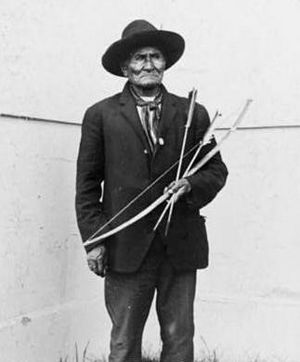
President Theodore Roosevelt opened the fair by telegraph. He did not visit in person until after his re-election in November 1904. He did not want to use the fair for political reasons.
Other famous visitors included:
- John Philip Sousa, a famous musician and composer. His band played on opening day.
- Thomas Edison, the inventor.
- Helen Keller, who was 24 and had just graduated from college. She gave a lecture.
- J. T. Stinson, a fruit expert, who said, "An apple a day keeps the doctor away" at a lecture.
- Alexandre Guilmant, a French organist, played many concerts on the world's largest organ.
- Geronimo, a famous Apache war chief. He was "on display" in a teepee.
- Grover Cleveland, a former U.S. president. He attended the opening ceremony.
- Henri Poincaré, a scientist, gave a speech about mathematical physics.
- Jack Daniel, the founder of Jack Daniel's whiskey. His whiskey won a gold medal at the fair.
- Novelist Kate Chopin lived nearby. She visited the fair on a hot day in August. She suffered a brain hemorrhage and died two days later.
- Max Weber, a German sociologist, visited to study capitalism.
- John McCormack, an Irish singer.
Postage Stamps
To celebrate the fair, the U.S. Post Office released five special stamps. They honored the 100th anniversary of the Louisiana Purchase.
- The 1-cent stamp showed Robert Livingston, who helped buy the land.
- The 2-cent stamp showed Thomas Jefferson, who made the purchase.
- The 3-cent stamp honored James Monroe, who also helped with the deal.
- The 5-cent stamp showed William McKinley, who helped plan the fair.
- The 10-cent stamp showed a map of the Louisiana Purchase.
- Louisiana Purchase Commemoratives
Images for kids
-
Flight Cage (Aviary)
See also
 In Spanish: Exposición Universal de San Luis (1904) para niños
In Spanish: Exposición Universal de San Luis (1904) para niños


